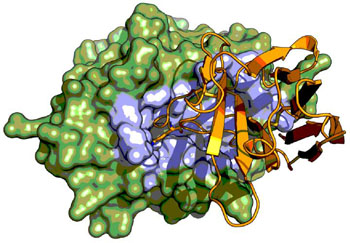Nanobodies Facilitate Studies of Enzyme Substrate Interactions
By LabMedica International staff writers
Posted on 29 Jun 2016
The unusual crystal structure of a nanobody in complex with a serine protease enzyme was established by X-ray crystallography.Posted on 29 Jun 2016
Serine proteases (or serine endopeptidases) are enzymes that cleave peptide bonds in proteins, in which serine serves as the nucleophilic amino acid at the (enzyme's) active site. Serine proteases fall into two broad categories based on their structure: chymotrypsin-like (trypsin-like) or subtilisin-like. In humans, they are responsible for coordinating various physiological functions, including digestion, immune response, blood coagulation, and reproduction.

Image: The figure depicts the X-ray crystal structure of the serine protease urokinase-type plasminogen activator (green) in complex with a Camelid antibody fragment (orange). The Camelid antibody fragment (nanobody) displays an unusual inhibitory mechanism by binding to the active site region (highlighted in blue) of the serine protease where it mimics the binding of substrate (Photo courtesy of Dr. Tobias-Kromann-Hansen, Aarhus University).
A peptide segment that binds the active site of a serine protease in a substrate-like manner may behave like an inhibitor or a substrate. However, there is little information on which factors determine which behavior a particular peptide segment will exhibit. To clarify this matter, investigators at Aarhus University (Denmark) determined the X-ray crystal structure of a nanobody in complex with a serine protease.
A nanobody (a single-domain antibody developed by the biotech firm Ablynx (Ghent, Belgium) is an antibody fragment consisting of a single monomeric variable antibody domain. Like a whole antibody, it is able to bind selectively to a specific antigen. With a molecular weight of only 12–15 kDa, single-domain antibodies are much smaller than common antibodies (150–160 kDa), which are composed of two heavy protein chains and two light chains, and even smaller than Fab fragments (approximately 50 kDa, one light chain and half a heavy chain) and single-chain variable fragments (approximately 25 kDa, two variable domains, one from a light and one from a heavy chain).
Single-domain antibodies from Camelids (camels, dromedaries, llamas, and their close relatives) have been shown to be just as specific as a regular antibody and in some cases they are more robust. They are easily isolated using the same phage panning procedure used for traditional antibodies, allowing them to cultured in vitro in large concentrations. The smaller size and single domain make these antibodies easier to manufacture in bulk in bacterial cells, making them ideal for research purposes.
The investigators reported in the May 23, 2016, online edition of the Journal of Biological Chemistry that the X-ray crystal structure of the nanobody-serine protease complex revealed that the nanobody displayed a new type of interaction, as it inserted its CDR-H3 loop into the active site of the protease in a substrate-like manner. The unique binding mechanism caused the nanobody to behave as a strong inhibitor as well as a poor substrate. The substrate behavior was incomplete, as 30-40% of the nanobody remained intact and inhibitory after prolonged incubation with the serine protease urokinase (uPA). Biochemical analysis revealed that an intra-loop interaction network within the CDR-H3 of the nanobody balanced its inhibitor versus substrate behavior.
Collectively, these results revealed molecular factors, which may be a general mechanism to determine the substrate versus inhibitor behavior of other protease inhibitors.
Related Links:
Aarhus University
Ablynx













